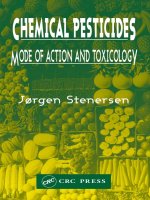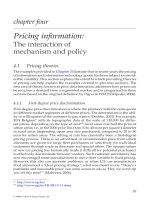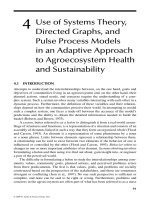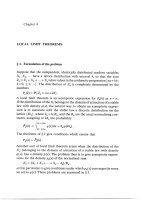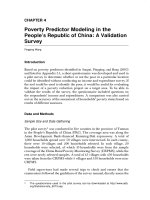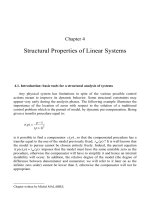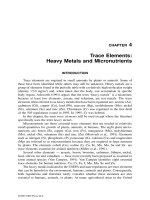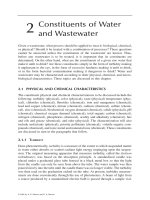Chemical Pesticides: Mode of Action and Toxicology - Chapter 4 ppt
Bạn đang xem bản rút gọn của tài liệu. Xem và tải ngay bản đầy đủ của tài liệu tại đây (43.35 KB, 6 trang )
chapter four
Bacillus thuringiensis and
its toxins
This chapter is based mainly on Glare and O’Callaghan (2000), Schnepf et
al. (1998), and Crickmore et al. (1998). Bacillus thuringiensis (Bt) is now the
most widely used biologically produced pest control agent. In 1995 world-
wide sales of B. thuringiensis were $90 million, representing about 2% of the
total global insecticide market. In 1998 nearly 200 insecticidal products were
registered in the U.S. Studies have so far not shown any pathogenic action
on mammals, birds, amphibians, or reptiles (Board of Agriculture and Nat-
ural Resources, 2000).
Bt was first described in 1911 when a bacillus was isolated from the
Mediterranean flour moth, Anagasta kuehniella. It is a Gram-positive,
rod-shaped, spore-forming bacterium that is closely related to Bacillus cereus,
a bacterium causing gastroenteritis in humans, and to Bacillus anthracis, a
very dangerous bacterium that can be used as a biological warfare agent.
The first isolation of Bt was done more than 100 years ago by the Japanese
biologist S. Ishiwata, who isolated a bacterium as the causal agent of a disease
of silkworms, but not before 1928, when a project that tried to utilize Bt
against a pest, the corn borer (Ostrinia nubilalis), was initiated. The presence
of a parasporal body in sporulating Bt cells was noted as early as 1915,
whereas its proteinaceous nature and its toxicity to silkworms were not
recognized before 1954. The potential of Bt as a pesticide was recognized in
the 1920s, and by 1992 more than 40,000 isolates were held in collections
throughout the world. Today it is more than 60,000. Strains active against a
wide variety of insects have now been isolated. These include Lepidoptera,
Diptera, Coleoptera, Hymenoptera, Hemiptera, and Mallophaga. Nematoda
and Protozoa are also susceptible to some strains. More than 170 genes
encoding for Bt toxins have been identified.
The toxins fall into one of these groups:
• δ-Endotoxins or Cry toxins
• Smaller cytosolic endotoxins (Cyt toxins)
• β-Exotoxins
©2004 by Jørgen Stenersen
• Hemolysins
• Enterotoxins
• Vegetative insecticidal proteins (VIPs)
• Exoenzymes
The genes responsible for the crystal proteins are called cry genes, and
the crystal toxin is called δ-endotoxin or Cry toxin, whereas the genes respon-
sible for toxic cytosolic proteins (Cyt toxins) are called cyt genes. Many Bt
strains are able to produce a number of such smaller cytosolic endotoxins
in addition to the δ-endotoxins, but these are often deposited in inclusion
bodies inside the crystals where they can comprise a considerable part of
the crystal. Unlike the Cry toxins, the other toxins display a broader unspe-
cific activity and may have some mammalian toxicity. They include the
β-exotoxins, hemolysins, and enterotoxins.
The β-exotoxin is sometimes called the fly toxin, but it has a broad
spectrum of activity, not confined to Diptera. It is thermostable and is not
destroyed by heating at 70˚C for 15 minutes. Because of the vertebrate
toxicity, most commercial preparations use subspecies or isolates that do not
produce β-exotoxin. However, the β-exotoxin can synergize the activity of
δ-endotoxin against natural tolerant insects. This synergy may result from
the inhibitory effect of β-exotoxin on the regeneration of midgut cells dam-
aged by δ-endotoxin. A new variant of β-exotoxin that is toxic to aquatic
mollusks has been described. It may be useful to control vectors of schisto-
somiasis and other snail-borne diseases, as well as snails in agriculture.
Hemolysins, which lyse vertebrate erythrocytes, are important virulence
factors in vertebrate bacterial pathogens. Such toxins are also found in some
Bt strains and seem to be identical to the hemolysin found in B. cereus. Some
Bt isolates have been found to produce the same type of diarrhea-producing
enterotoxins as B. cereus. Bt may therefore have implications in causing
gastroenteritis.
Bt produces and secretes a number of enzymes, e.g., chitinases, proteases,
and phospholipases, of importance to the pathogenicity. They disrupt the per-
itrophic membrane, providing access for the true toxins to the gut epithelium.
A new class of insecticidal toxins called vegetative insecticidal proteins
has recently been isolated from Bt. They are produced during the vegetative
growth stage. The proteins are different from other known proteins, and
their function and versatility for insect control have yet to be elucidated.
4.1 The mechanism of action of δ-endotoxins
As mentioned, the δ-endotoxin (Cry protein) that makes up most of the
conspicuous crystals is the main insecticidal component of B. thuringiensis.
At sporulation, the majority of Bt strains produce crystalline inclusions that
contain this insecticidal δ-endotoxin. The crystals account for 20% or more
of the total bacterial protein at sporulation and may contain one or several
endotoxins, which differ in activity. Many Bt toxin genes and genes for some
©2004 by Jørgen Stenersen
endotoxins are encoded by extrachromosomal DNA, often located on large
plasmids. (A plasmid is a small circular DNA molecule often present in
bacterial cells. It replicates independently and can be transferred naturally
or artificially to other bacteria.) One plasmid may have genes for more than
one type of endotoxin. The cry genes can also be located on the bacterial
chromosome. Even genes encoding the same protein may be located both
on plasmids and on the chromosome. The amino acid sequences of the toxins
are now easier to obtain experimentally than they were earlier; hence, it
follows that the classification and nomenclature could be based on sequence
similarity that reflects phylogeny, and not the biological activity.
The amino acid sequence is used for classification, first in superfamilies
Cry1, Cry2, etc. If the sequence is more similar, a letter is added (Cry1A,
Cry1B, etc.) and the individual proteins are called Cry1A1, Cry3B3, etc. Other
older classification and designation systems, not based on amino acid
sequence, are still in use.
The δ-endotoxins and the other Bt toxins function only as stomach poi-
sons. A susceptible insect must eat them, and the crystals dissolve in the
midgut. This solubilization is sometimes dependent on chymotrypsin-like
enzymes. The protoxin is further attacked by proteolytic enzymes present
in the gut that convert it to the active toxin. An interesting and unexpected
finding is that DNA is intimately associated with the toxin crystal and
appears to play a role in the proteolytic processing.
The active toxin has two main functional entities, responsible for receptor
binding and ion channel activity, respectively. The activated toxin binds to
receptors, which seem to be of different types, on the midgut microvilli of
the susceptible insects. Different toxins seem to bind to different receptor
proteins that may be an enzyme such as aminopeptidase or alkaline phos-
phatase, or a cadherin-like membrane protein. (The cadherins are proteins
that are important in keeping the cells together by mediating Ca
+
-dependent
cell–cell adhesion in animal tissue.) The toxins are anchored to the outer
epithelial cell membrane in such a way that the membrane is perforated by
pores or channels where ions can freely pass. This model proposes that an
influx of water, along with ions, results in swelling and lysis. The epithelium
is destroyed and the insect rots.
Consumption of food treated with the endotoxins, or engineered plants
that produce them, results in cessation of feeding of Lepidoptera larvae and
paralysis of the gut that retards the passage of food and allows the spores
to germinate. The larvae suffer a general paralysis and die. Bt israelen-
sis-treated mosquito larvae cease feeding within 1 hour of treatment, show
reduced activity after 2 hours, and general paralysis after 6 hours. In beetles
death may take longer.
Engineering of Cry proteins to create better pesticides is possible. A
mutant of Cry4B resulted in a threefold increase of toxicity against the
mosquito, perhaps by removal of a site sensitive to proteolytic instability.
More often, increased receptor binding causes the increased efficiency of
mutant types.
©2004 by Jørgen Stenersen
4.2 Biotechnology
Crystal genes have been introduced into other bacteria such as Escherichia
coli, Bacillus subtilis, Bacillus megatorium, and Pseudomonas fluorescens. Fermen-
tations of recombinant Pseudomonas have been used to produce concentrated
aqueous biopesticide formulations consisting of Cry inclusions encapsulated
in dead cells. Engineered forms of Cry proteins may show improved potency
or yield and may make them a more attractive and practical alternative or
supplement to other traditional pesticides. The gene has also been intro-
duced into a bacterium (Clavibacterium xyli) that lives inside plants. When
corn is infested with this bacterium, the crop is protected against corn borer.
Other endophytic microorganisms (Azospirillum spp., Rhizobium, etc.) have
also been engineered, and cry genes specifically active to Diptera have been
introduced into other bacteria, including Cyanobacteria.
4.3 Engineered plants
In order to get an optimal production of toxins in plants, the cry gene from
Bt must be modified extensively before being introduced into the plant’s
genome, and only the part of the gene that codes for the active part of the
Bt toxin is used. Full-length unmodified cry genes give quite inefficient toxin
production. Varieties of potato, cotton, corn, and many other plants contain-
ing modified cry genes are now available on the market in some countries.
The marketing started in 1996 and the proponents for such plants are very
enthusiastic. Because the toxins are produced continuously and apparently
persist for some time in the plant tissue, fewer, if any at all, chemical pesti-
cides must be used. Beneficial insects are not harmed. However, the public
opinion, notably that of environmentalists, is skeptical. There are fundamen-
tal beliefs that such gene manipulations are to play the role of God, or are
to intervene with natural selection in an unethical and unacceptable way. Other
more trivial arguments may be more relevant to the rational mind, i.e., that
there may be some unknown health or ecological effects. It is outside my field
of knowledge to offer a qualified opinion about these important questions.
4.4 Biology
A biologist will want to know something about the relationship of Bt to other
bacteria, the natural function, if any, of the toxins, as well as the natural
occurrence of the Bt strains. Numerous strains have been isolated from a
wide range of habitats such as soil, mushroom compost, and stored products.
Bt may be present in samples from beach deserts and tundra, and may
multiply in cadavers of insects and other animals. Insecticidal activity does
not correlate with the origin of the isolate, and many of them do not seem
to be toxic for insects. Bt may be regarded as a ubiquitous soil microbe and
common on vegetation. Their spores may be viable for years in the soil
©2004 by Jørgen Stenersen
environment. Of viable bacterial spores present on foliage on various decid-
uous and conifer trees, Bt often accounts for 30 to 100%. Viable spores are
also quite common on grasses and herbs. The natural function of the toxins
may be connected to this habitat. If insects visiting the plant surfaces are
infected, they are killed by the toxins and make an excellent food source for
the bacterium.
As mentioned, Bt makes a taxonomic group together with Bacillus anthra-
cis and B. cereus. Bt and B. cereus are so closely related, both serologically
and by various methods using DNA sequences, that they may be regarded
as one species. The much feared toxin of B. anthracis is different from the
δ-endotoxin of Bt. The B. anthracis toxin produces three factors — lethal
factor, protective antigen, and edema factor — that are encoded by three
different genes. The protective antigen recognizes and binds to certain recep-
tors on the cell membrane, where they form a pore. The lethal factor and
edema factor bind to the protective antigen and are taken into the cell by a
process called endocytosis. After uptake, the lethal factor acts as a protease
that specifically splits an enzyme important for internal signaling in the cell
(MAP kinase, or MAPKK1 and MAPKK2). MAP kinase is an abbreviation
of “mitogen-activated protein kinase,” which is described in Alberts et al.
(2002) and other cell biology textbooks. The edema factor acts also as an
enzyme (adenylate cyclase) that inhibits immune response. The anthrax
toxins are therefore different from the δ-endotoxin of Bt, although the making
of pores is a related mechanism.
4.5 Commercial products
The first commercial product that appeared in 1938 for use against lepi-
dopterous larvae was Sporeine, which was produced by several companies.
Names of other old products are Dipel WP, a wettable powder, and Dipel
LC, a liquid concentrate used for aerial low-volume application. The
Bt-based microbial pesticides have so far been the most successful biopesti-
cides. The rapid growth of Bt-based pesticides is occurring as replacements
of chemicals that were banned or phased out in environmentally sensitive
areas, in consumer and export markets in which concerns about food residue
are high, and in organic food production. The current sales are at least $140
million. Today the commercial products are based on various strains of the
more than 26 different subspecies.
The several strains of the subspecies Bt kurstaki, or strains of Bt kurstaki
with various cry genes from Bt aizowai, Bt morrisoni, and Bt kumatoensis, are
marketed for use against lepidopterous larvae, or in some cases against
Colorado beetles. Bt is now sold under about 30 trade names. Preparations
with Bt tenebrionis are used against Colorado beetle, and Bt japonensis may be
used against soil-inhabiting beetles in turf and ornamentals. Even more inter-
esting is Bt israelensis, which is used in aerial applications against mosquito and
blackfly larvae. It is also sold under many different trade names.
©2004 by Jørgen Stenersen
Various preparations of δ-endotoxin (Cry1A(c), Cry1C, or Cry3A) are
also marketed. The toxins are produced by engineered Pseudomonas fluo-
rescence and are formulated as microcapsules or as granular formulations.
They are used against Lepidoptera, armyworms, Colorado beetles, and
corn borers.
National approval authorities in some countries hesitate to approve Bt
preparations because of the similarities between B. thuringiensis and the
pathogenic species B. anthracis and B. cereus. However, no ecotoxicological
or human toxicity seems to be associated with Bt itself or its toxins. The
half-life in soil is short, and it is destroyed by sunlight. The questions about
possible ecological consequences of Bt plants are not yet settled.
©2004 by Jørgen Stenersen
